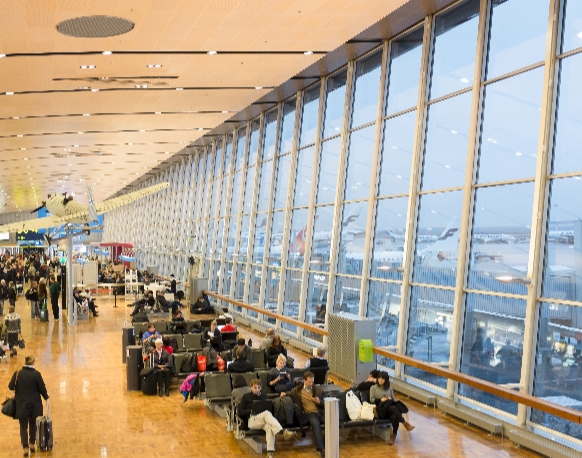Up
Introduction Helsinki-Vantaa Airport, Finland
Helsinki-Vantaa Airport, located in Vantaa, Finland, is the country’s premier international airport. Serving as a vital air transportation hub, it connects Finland to various global destinations.
With modern facilities, efficient services, and a strategic location, the airport plays a crucial role in facilitating both domestic and international travel.
Passengers at Helsinki-Vantaa Airport experience a seamless journey with its state-of-the-art terminals, offering a range of amenities from shopping and dining to lounges for relaxation. As a key hub for Finnair, the national airline, and a base for numerous other carriers, the airport contributes significantly to the region’s connectivity.
Notable for its Nordic design and efficiency, Helsinki-Vantaa Airport reflects Finland’s commitment to providing a world-class travel experience. Its well-connected transportation links, including a railway station directly connected to the airport, enhance accessibility for travelers.
Whether arriving or departing, Helsinki-Vantaa Airport stands as a modern gateway, embodying Finnish hospitality and functionality.
Helsinki-Vantaa Airport, Finland Profile data
Here is general profile information about Helsinki-Vantaa Airport :
– Location: Vantaa, Finland
– Type: International Airport
– Operator: Finavia
– Terminals: Two passenger terminals (T1 and T2)
– Airlines: Serves as a hub for Finnair and a base for numerous other carriers.
– Facilities: Modern amenities including shopping, dining, lounges, and conference services.
– Connectivity: Well-connected with a railway station directly linked to the airport.
– Importance: Key hub for both domestic and international air travel in Finland.
Sustainability in Helsinki-Vantaa Airport, Finland
Helsinki-Vantaa Airport has made notable strides in sustainability, here are some aspects of its sustainability initiatives:
1. Energy Efficiency: The airport has implemented measures to enhance energy efficiency, including the use of renewable energy sources where possible.
2. Waste Management: Efforts have been made to reduce waste and improve recycling practices within the airport premises.
3. Carbon Neutrality: Helsinki-Vantaa has worked towards carbon neutrality by investing in carbon offset projects and implementing energy-saving technologies.
4. Public Transportation: The airport encourages the use of public transportation, with a direct railway connection to the city center, contributing to reduced carbon emissions from passenger travel.
Energy Efficiency in Helsinki-Vantaa Airport
Helsinki-Vantaa Airport has prioritized energy efficiency through various measures:
1. Renewable Energy: The airport has incorporated renewable energy sources, such as wind and solar power, to reduce its environmental impact.
2. Energy-Saving Technologies: Implementation of energy-efficient technologies and practices, including LED lighting and energy-efficient heating, ventilation, and air conditioning (HVAC) systems.
3. Monitoring and Optimization: Continuous monitoring and optimization of energy consumption to identify areas for improvement and reduce overall energy usage.
4. Certifications: Pursuit of certifications, such as ISO 14001 for environmental management, indicating a commitment to sustainable practices.
These efforts align with the broader goals of reducing the airport’s carbon footprint and enhancing overall sustainability.
Waste Management in Helsinki-Vantaa Airport
Helsinki-Vantaa Airport has implemented waste management initiatives to enhance sustainability:
1. Recycling Programs: The airport promotes recycling practices for various waste materials, including paper, plastic, and glass.
2. Waste Sorting Facilities: Adequate waste sorting facilities are available throughout the airport to facilitate proper disposal and recycling.
3. Reduction Strategies: Initiatives aimed at reducing overall waste generation, such as encouraging the use of reusable items and minimizing single-use plastics.
4. Collaboration: Collaboration with waste management partners and local authorities to ensure effective waste disposal and recycling processes.
By focusing on waste reduction and responsible disposal, Helsinki-Vantaa Airport aims to minimize its environmental impact and contribute to a more sustainable aviation industry.
Monitoring and optimization of energy consumption in Helsinki-Vantaa Airport
Helsinki-Vantaa Airport employs monitoring and optimization strategies for energy consumption, including:
1. Advanced Systems: Utilization of advanced systems for real-time monitoring of energy usage throughout the airport infrastructure.
2. Data Analysis: Regular analysis of energy consumption data to identify patterns, peak usage times, and areas where improvements can be made.
3. Energy-Efficient Technologies: Implementation of energy-efficient technologies and equipment to reduce overall energy consumption.
4. Continuous Improvement: Ongoing efforts to identify opportunities for improvement and implement changes to optimize energy efficiency.
By actively monitoring and optimizing energy usage, Helsinki-Vantaa Airport aims to enhance sustainability, reduce environmental impact, and contribute to more efficient operations.
Helsinki-Vantaa Airport Certifications
Helsinki-Vantaa Airport holds various certifications indicating its commitment to environmental and operational standards.
Some certifications include:
1. ISO 14001: This certification reflects adherence to international standards for environmental management systems, emphasizing the implementation of effective environmental practices.
2. ACA Certification: Airport Carbon Accreditation certifies airports for their efforts in managing and reducing carbon emissions. Helsinki-Vantaa Airport has been actively working toward carbon neutrality.
3. IATA’s CEIV Pharma: Certification for handling pharmaceutical products, ensuring compliance with international standards in the transportation of temperature-sensitive pharmaceutical goods.
Traffic Management Control in Helsinki-Vantaa Airport, Finland
Helsinki-Vantaa Airport employs a comprehensive Traffic Management Control system to ensure efficient and safe air traffic operations.
Key aspects include:
1. Air Traffic Control (ATC): The airport has an ATC tower overseeing arrivals and departures, providing instructions to pilots for safe and orderly movement on the ground and in the airspace.
2. Ground Control: Ground Control manages the movement of aircraft on the taxiways and runways, coordinating with the ATC tower to ensure smooth transitions between ground and air operations.
3. Collaboration with Airlines: Coordination with airlines to manage the flow of arriving and departing flights, optimizing scheduling to prevent congestion and delays.
4. Technology Integration: Integration of advanced technologies for radar surveillance, communication, and navigation to enhance overall traffic management efficiency.
Efficient traffic management is crucial for maintaining safety and minimizing delays at Helsinki-Vantaa Airport, contributing to a smooth travel experience for passengers and efficient operations for airlines.
Latest Facilities in Helsinki-Vantaa Airport
Helsinki-Vantaa Airport generally undergo continuous improvements and expansions to enhance passenger experience.
Common types of facilities in Helsinki-Vantaa Airport include:
1. Terminals: Modern and well-equipped terminals with amenities such as lounges, shopping, and dining options.
2. Technology Integration: Implementation of advanced technologies for check-in, security, and baggage handling to streamline processes.
3. Sustainable Initiatives: Integration of sustainable features, such as energy-efficient systems and waste management practices.
4. Transportation Links: Efficient transportation links, including direct rail connections and parking facilities.
Development of Helsinki-Vantaa Airport
The development of Helsinki-Vantaa Airport has been marked by ongoing efforts to enhance its infrastructure, services, and sustainability.
Key aspects of its development include:
1. Capacity Expansion: Periodic expansions to accommodate increasing passenger numbers and air traffic demand.
2. Terminal Upgrades: Renovations and upgrades to terminals, improving facilities, and providing a better passenger experience.
3. Technology Integration: Continued integration of advanced technologies for more efficient and secure operations.
4. Sustainability Initiatives: Emphasis on sustainability with measures such as energy-efficient systems, waste management, and certifications for environmental standards.
5. Collaboration with Airlines: Working closely with partner airlines to optimize flight schedules and improve overall operational efficiency.
Conclusion for Exploring Sustainability in Helsinki-Vantaa Airport, Finland
Helsinki-Vantaa Airport in Finland exemplifies a commitment to sustainability through a multifaceted approach. From energy-efficient technologies and waste management programs to certifications and continuous development, the airport stands as a model for environmentally conscious aviation.
These initiatives not only reflect the airport’s dedication to reducing its environmental impact but also contribute to the broader goals of creating a more sustainable and resilient air travel industry. As Helsinki-Vantaa Airport continues to evolve and implement innovative practices, it sets a positive example for airports worldwide seeking to balance operational efficiency with environmental responsibility.
https://www.exaputra.com/2023/11/exploring-sustainability-in-helsinki.html
Renewable Energy
Before Trump, “Contempt of Court” Used to Be a Big Deal
 Most Americans, me included, are puzzled as to how the Trump administration can openly thumb its nose to the findings of our courts. Until recently, behavior like this would have wound you up in jail.
Most Americans, me included, are puzzled as to how the Trump administration can openly thumb its nose to the findings of our courts. Until recently, behavior like this would have wound you up in jail.
Renewable Energy
How Households Saved $1,200 with VEU & Air-Con Upgrade?
Renewable Energy
Air Power
 About 20 years ago, a friend asked me if I was aware that cars could run on air. I asked, delicately, what she meant, and she explained that cars can run on compressed air.
About 20 years ago, a friend asked me if I was aware that cars could run on air. I asked, delicately, what she meant, and she explained that cars can run on compressed air.
“Ah,” I replied. “Of course they can. But where does the energy come from that compresses the air?” End of conversation.
Now, it’s back. Now there are enormous swaths of the population who know so little about middle school science that they believe we can put cars on the road, in an ocean of air, and extract energy out of that air to power our automobiles.
If you’re among these morons and want to invest with some heavy-duty fraud/charlatans, here’s your opportunity. They say that it’s “self-sustaining and needs no fuel.” If that makes sense to you, be my guest.
-
Climate Change4 months ago
Guest post: Why China is still building new coal – and when it might stop
-
Greenhouse Gases4 months ago
Guest post: Why China is still building new coal – and when it might stop
-
Climate Change2 years ago
Spanish-language misinformation on renewable energy spreads online, report shows
-

 Greenhouse Gases2 years ago
Greenhouse Gases2 years ago嘉宾来稿:满足中国增长的用电需求 光伏加储能“比新建煤电更实惠”
-
Climate Change Videos2 years ago
The toxic gas flares fuelling Nigeria’s climate change – BBC News
-

 Climate Change2 years ago
Climate Change2 years ago嘉宾来稿:满足中国增长的用电需求 光伏加储能“比新建煤电更实惠”
-

 Carbon Footprint2 years ago
Carbon Footprint2 years agoUS SEC’s Climate Disclosure Rules Spur Renewed Interest in Carbon Credits
-
Renewable Energy5 months ago
US Grid Strain, Possible Allete Sale






















